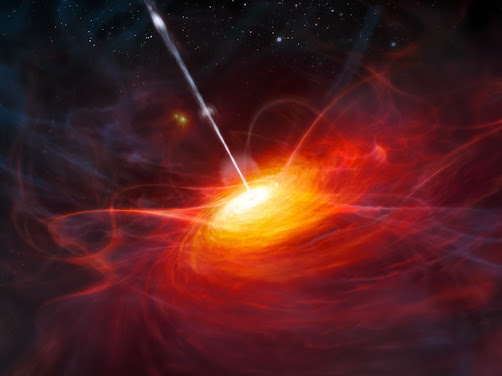ULAS J1120+0641
 |
Credit : ESO/M. Kornmesser
|
Quasi-stellar object is an extremely luminous with active galactic nucleus. As the all black hole has ULAS J1120+0641 is surrounded by a gaseous accretion disk with the mass of millions to billions of the mass of the sun. quasar name ULAS is from ULAS[Large Area Survey].
The Quasar is located in the constellation of Leo. The Quasar ULAS J1120+0641 is the second most distant known Quasar after ULAS J1120+0928.this massive quasar is discovered in June 2011 at 28.85 billion light years away from the earth. By using UK Infrared Deep Sky Survey telescope(UKIDSS). this quasar is located in the constellation of LEO. the quasar ULAS J1120+0641 is the first quasar discovered beyond a redshift of 7. The quasar ULAS j1120+0641 was discovered by a telescope that operates at infrared wavelengths, which is at longer wavelength and lower energy than visible light; But in fact the light is emitted by the quasar is ultraviolet. In comparison Ultraviolet light has shorter wavelength and higher energy than visible light. But the redshift is the reason why the wave length is changed during the light's journey in the universe.
Credit: ESO/M. Kornmesser
The light which is observed on the earth is about 13 billion years ago, it may be that the quasar ULAS j1120+0641 is dead. the light is 100 million years earlier than the earth was born. the most distant quasar ULAS j1120+0641 has luminosity 63 trillion times that of the sun's luminosity. this is very much energy
output which is generated by super massive blackhole about 2 billion times in mass
that of the sun. black hole it self is dark but it has a disc of gas or dust around it
that has become so hot that it will outshine an entire galaxy of stars.
The light from ULAS J1120+641 was emitted before the end of the theoretically
predicted of the intergalactic medium from an electrically neutral to an ionized state.
Quasars may have been an important energy source in this process, which marked
the end of the cosmic Dark Ages, so observing a quasar from before the transition
is of major interest to theoreticians.
This is the first time scientists have seen a quasar with such a large fraction of neutral (non-ionized) hydrogen absorption in its spectrum. Mortlock estimates that 10% to 50% of the hydrogen at the redshift of ULAS J1120+0641 is neutral. The neutral hydrogen fraction in all other quasars seen, even those only 100 million years younger, was typically 1% or less. The spectrum also lacked any significant indication of non-BBN metals. The combination of the neutral hydrogen reading, and lack of metals is suggestive of the quasar being embedded in a protogalaxy in the midst of forming, and possibly creating the first population III stars for the galaxy, or a pre-protogalaxy core still embedded in the primordial hydrogen fog, predating the Population III stellar population for this galaxy.
The supermassive black hole in ULAS J1120+0641 has a higher mass than was expected. The Eddington limit sets a maximum rate at which a black hole can grow, so the existence of such a massive black hole so soon after the Big Bang implies that it must have formed with a very high initial mass, through the merging of thousands of smaller black holes, or that the standard model of cosmology requires revision.
visit us on:YouTube




Comments
Post a Comment